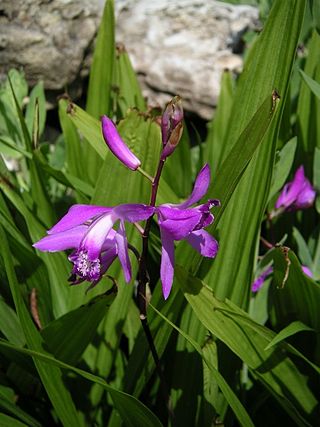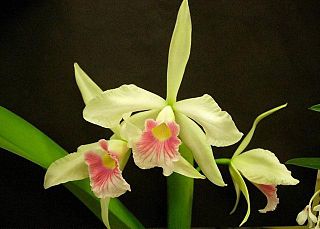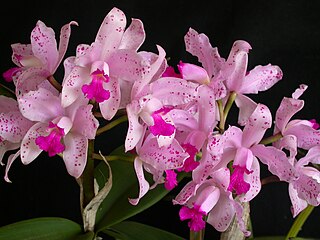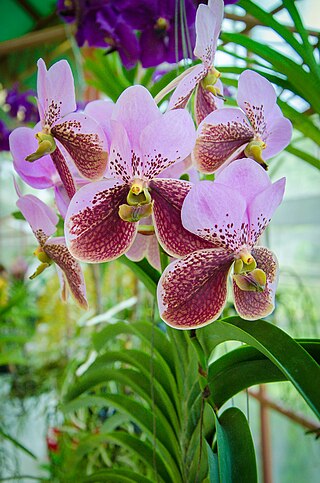
Cattleya is a genus of orchids from Costa Rica south to Argentina. The genus is abbreviated C in trade journals.

Laelia is a small genus of 25 species in the orchid family (Orchidaceae). Laelia species are found in areas of subtropical or temperate climate in Central and South America, but mostly in Mexico. Laelia is abbreviated L. in the horticultural trade.

Commonly known as hellebores, the Eurasian genus Helleborus consists of approximately 20 species of herbaceous or evergreen perennial flowering plants in the family Ranunculaceae, within which it gave its name to the tribe of Helleboreae. Despite names such as "winter rose", "Christmas rose" and "Lenten rose", hellebores are not closely related to the rose family (Rosaceae). Many hellebore species are poisonous.

Miltonia, abbreviated Milt. in the horticultural trade, is an orchid genus comprising twelve epiphyte species and eight natural hybrids. The miltonias are exclusively inhabitants of Brazil, except for one species whose range extends from Brazil into the northeast of Argentina and the east of Paraguay.

Bletilla, common name urn orchid, is a temperate, terrestrial genus of orchids containing five currently recognized species distributed through China, Japan, Taiwan, south to Vietnam, Thailand and Myanmar. The name is actually a diminutive of Bletia because of the resemblance between the two genera even though Bletia is a New World genus. The genera JimensiaRaf. and PolytomaLour. ex Gomes are generally included into Bletilla. This genus is abbreviated Ble in trade journals.

Anacamptis morio, the green-winged orchid or green-veined orchid, is a flowering plant of the orchid family, Orchidaceae. It usually has purple flowers, and is found in Europe and the Middle East.

Leptotes, abbreviated Lpt in horticultural trade, is a genus of orchids formed by nine small species that grow in the dry jungles of south and southeast Brazil, and also in Paraguay or Argentina. They are small epiphytic plants of caespitose growth that sometimes resemble little Brassavola, as they share the same type of thin terete leaves, though they are more closely related to Loefgrenianthus.

Laeliocattleya is a nothogenus of intergeneric orchid hybrids descended from the parental genera Laelia and Cattleya. It is abbreviated Lc. in the horticultural trade.

Corallorhiza maculata, or spotted coralroot, is a North American coralroot orchid. It has four varieties: C. maculata var. occidentalis, C. maculata var. maculata, C. maculata var. mexicana, and C. maculata var. ozettensis. It is widespread through Mexico, Guatemala, Canada, St. Pierre & Miquelon, and much of the western and northern United States. It grows mostly in montane woodlands.

Cattleya purpurata, known in the past as Laelia purpurata and Sophronitis purpurata, is native to Brazil where it is very popular among orchid growers. It is an epiphyte that is found in the canopy of tall trees near coastal areas, in the Brazilian states of Rio Grande do Sul, Santa Catarina and São Paulo. The orchid favors bright light and cool to warm conditions and is relative easy to cultive. C. purpurata has been used extensively as a parent in hybridizing with Cattleyas. Cattleya purpurata blooms from late spring to fall with three to five flowers on a spike. The flowers are long-lasting and fragrant.

Phalaenopsis equestris is a flowering plant of the orchid genus Phalaenopsis and native to Philippines and Taiwan. The inflorescence has 10 to 20 flowers of about 25 mm (1 in) diameter.

Cattleya amethystoglossa is a bifoliate species of orchid from the genus Cattleya.

Cattleya maxima is a species of orchid in subfamily Epidendroideae found from Ecuador to Peru.

Cymbidium canaliculatum, commonly known as the channelled boat-lip orchid, tiger boat-lip orchid, native cymbidium or tiger orchid is a plant in the orchid family and is endemic to Australia. It is a clump-forming epiphyte with large, greyish green pseudobulbs, each with up to six curved, deeply channelled leaves and up to sixty fragrant, variably coloured flowers that often have spots and blotches and a white to cream-coloured labellum with red markings. This orchid usually grows in the forks or hollows of trees and is found from New South Wales to the northern parts of Western Australia.

Cymbidium eburneum, the ivory-colored cymbidium, is a species of orchid.

Phalaenopsis bellina is an orchid endemic to Borneo. It is one of 75 species of Phalaenopsis and one of the most commonly cultivated species in the genus.

Vanda sanderiana is a species of orchid. It is commonly called Waling-waling in the Philippines and is also called Sander's Vanda, after Henry Frederick Conrad Sander, a noted orchidologist. The orchid is considered to be the "Queen of Philippine flowers" and is worshiped as a diwata by the indigenous Bagobo people.
Encyclia fehlingii is a species of orchid that was named for Gladys Fehling who lived on Andros Island in the Bahamas and spent much of her time searching for the orchids of the area and growing them for her own pleasure. The plants of Encyclia fehlingii are epiphytic and grew mostly in the Fresh Creek area on Andros, but the species has also been found on New Providence Island and on Abaco.

Cattleya rex is a species of epiphytic orchid of showy white flowers, native to montane forests in Peru and Bolivia.

Caladenia oenochila, commonly known as the red-lipped spider orchid, or wine-lipped spider orchid, is a plant in the orchid family Orchidaceae and is endemic to Victoria, Australia. It is a ground orchid with a single leaf and usually only one pale yellow-green flower with purple marks and a dark red labellum.



















